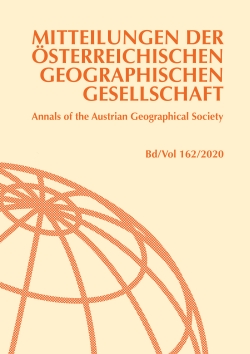
Mitteilungen der Österreichischen Geographischen Gesellschaft Band 162/2020, pp. 155-210, 2021/03/30
Band 162 (Jahresband), Wien 2020
Volume 162 (Annual volume), Vienna 2020

Scientific societies are among the most influential modes of scientific organisation. Emerging as bourgeois associations, mainly in the second half of the nineteenth century, these societies saw themselves as communication platforms for scholars and practitioners from diverse educational backgrounds. The boom of scientific societies in the capital of the Habsburg Empire during a period of great economic upswing led to both disciplinary differentiation and an increase in membership. Associations such as the Imperial-Royal Geographical Society (1856), the Club of Geographers at the University of Vienna (1874) and the Geological Society (1907) brought together members from all the crownlands of the monarchy. At their height, these societies were among the leading European players in their field, holding and administering funds and running expeditions. The outbreak of World War One offered them new scope to innovate and adapt, but the political dynamics of its aftermath, together with the loss of financial reserves, the erosion of traditional research fields and the cessation of scientific exchange with non-German-speaking countries, ultimately caused their long-term decline. The crisis of bourgeois society in the 1920s was closely bound up with the crisis of the bourgeois scientific societies, which were increasingly dominated by state research institutions; subsequently, some of these societies became rallying points for political radicalism. Based on archival research and statistical analysis, this paper will examine the correlation of scientific and political processes between 1850 and 1925 and their impact on the empire’s geoscientific research landscape. Particular attention will be paid to (1) the relationship between associations, state and public in the context of imperial statehood, bourgeois self-empowerment and disciplinary transformations, and (2) the impact of regime change, territorial reconfiguration and social upheaval on the societies’ practices of knowledge production and dissemination after 1914.
Keywords: Scientific societies, Imperial-Royal Geographical Society, Geological Society, geography, geology, Habsburg Empire, First Austrian Republic, boundarywork, geographies of science, World War One